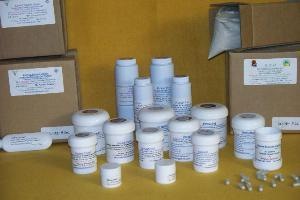
First of all- let's be safe about these things, OK? Every mineral resource is different and with those differences come differing actions and effects. DO NOT just make presumption that what you have is safe just because it looks so innocuous. You can and should do your own testing to suit your own verification needs. Understanding of bentonites (montmorillonites) requires analytics.
Test #1- VISUAL: look at it. Does it look colored? Hold a sheet of white paper beside it- how does it look compared to real white? Is this a powder that you have or is it granular? Start making a list of notes. This will matter later. #2- Touch it. DO NOT TASTE IT! That will come later- much later. Be prepared to wash/rinse your hand off. Don't make any presumption. Make a note of how it feels: smooth/rough, fine/coarse. Powders are all eyes, nose and lungs hazards, so do not let any dust get into your body. Rinse or wash accordingly. Note how it feels to you. #3- Water or hydration test: take a small amount of the material in a clear glass and add about 3 or 4 times that amount of water into it. Note what happens- nothing much? Does it really spread out into the water or does it basically sink to the bottom and stay there. Set this somewhere you can leave it alone for an hour, then come back and look at it. Does it all sit on the bottom or has it floated in suspension. HAs it separated into layers? Make a couple notes of it's apparent behavior. This will matter later. #4- Screening: This is the basic size testing and filtering of the clay particles, which are defined as being sub-400 mesh size, from the micro- and mini- sand particles which can be considered contaminants, although they may not be harmful and can even be beneficial for some uses. #5- Compaction: When clays are moisturized, they become "plastic"- that being easily moldable. There is an optimal moisture content in this so that the clay can be condensed and compacted to a measurable density. Clays are very sensitive and "peaky" for the optimal clay/water ratio or percentages. #6- Atterburg test: This is another mechanical characteristic test showing transition levels of the clay/silts of different particle sizes and the relative moisture content. This is mostly used, from my limited experience, in construction with clays requiring compaction. As with cements, there is benefit to having a certain "grit" or solids content. #7- Shrinkage: As clays are moistened, they expand with acceptance of the water. When they dry, they then shrink. This is a primary physical difference between sodium bentonites and calcium bentonites. Due their 3-layer construction, sodium bentonites swell markedly with moisture, whereas calcium bentonites, with a 2-layer structure, do not so swell. This is also commonly termed the "swell index", as opposed to the shrinkage when drying. #8- Permeability: #9- ICP Scan: #10- X-Ray Diffraction: #11- X-Ray Fluorescence: #12- Cation Exchange Capacity (CEC): #13- Thermal Analysis: #14- Scanning Electron Microscope (SEM): | ||

 Then- you can go ahead and formulate to your heart's content, knowing your are working with the best for your customer's satisfaction.
Then- you can go ahead and formulate to your heart's content, knowing your are working with the best for your customer's satisfaction.